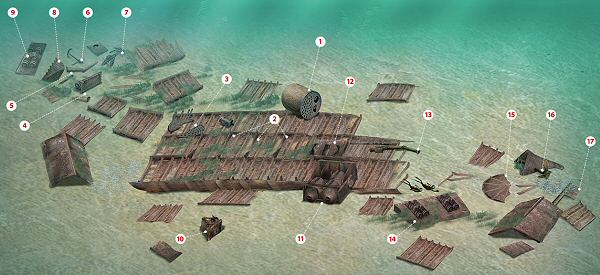Shallow enough for a nice long dive is this steamer that sank off south-eastern Scotland 116 years ago. JOHN LIDDIARD is our tour guide, illustration by MAX ELLIS
HAVING BEEN ALL THE WAY SOUTH to Guernsey last month, this month we are heading a fair way north, to Scotland’s Firth of Forth.
The wreck of the 1339-ton steamship River Garry is located just over a mile from the bleak grey façade of the Torness nuclear power station, though this is obviously not something the crew would have appreciated as the ship foundered in hurricane force winds in 1893, with the loss of all hands.
Our tour begins on the boiler, which remains intact (1), having rolled across the flattened hull to be almost off the starboard side of the wreck. The River Garry was unusual in having two boilers in a tandem configuration, as shown by the wedge-shaped mounts for a pair of boilers lined up along the keel (2).
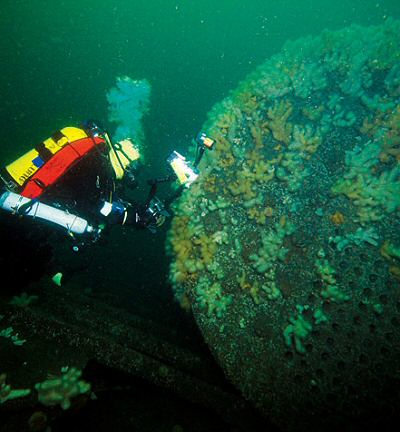
The second boiler has not survived so well. All that remains are sections of the round end plates and some boiler tubes (3) scattered just forward and to starboard of the forward boiler-mounts.
Continuing towards the bow, forward of the boiler-mounts the hull is more broken, with ribbed plates scattered on the seabed and the wreckage biased slightly to starboard.
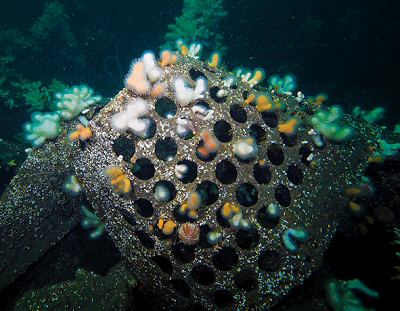
This may have been from the original wrecking, or possibly a sign that the forward part of the wreck fell to starboard as it split from the rest of the hull.
Following the trail of hull-plates, the next recognisable item of wreckage is the anchor-winch (4), still intact on its mounting-plate but tipped forward.
This is not surprising, as while deck machinery would have been mounted on steel plates, these in turn would have been fitted to a mostly wooden deck that has rotted away long ago.
Forward of the anchor-winch, a pair of anchor hawse-pipes lie flat on the seabed (5). Then, slightly to starboard, you’ll see a large Admiralty-pattern anchor (6).

A little further to starboard are three more anchors, stacked neatly on top of one another (7). These would have been stowed like this on the River Garry’s bow deck, then fallen to the seabed as a group as the wreck decayed.
Back in line with the hawse-pipes and anchor-winch, a section of the stem of the bow lies tipped on one side (8). But the wreckage does not end here. Just forward of the bow is the cargo-winch (9), which would have served the forward hold. It’s intact and upright on its mounting-plate.
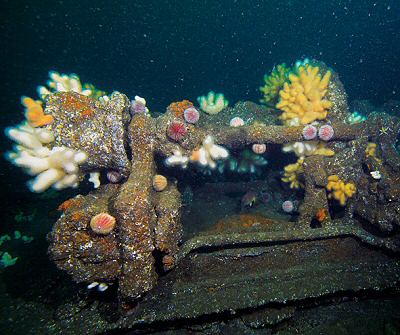
As to how it ended up here, I can only speculate. Perhaps it was moved during salvage operations. Iain Easingwood’s grandfather worked as a hardhat salvage diver on this wreck, among others, and his photograph in full hardhat gear hangs in the Harbourside in Eyemouth.
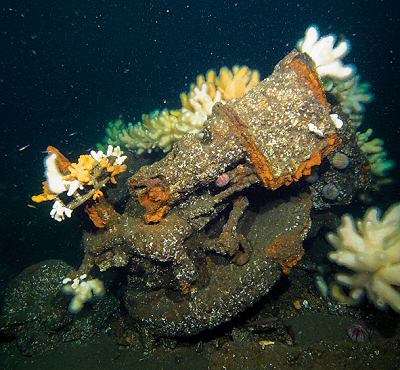
Heading aft again, off the port side of the wreck and level with the boiler-mounts is the helm and steering-engine (10). Also fallen to the port side of the keel is the River Garry’s two-cylinder compound engine (11), its top pointing away from the wreck.
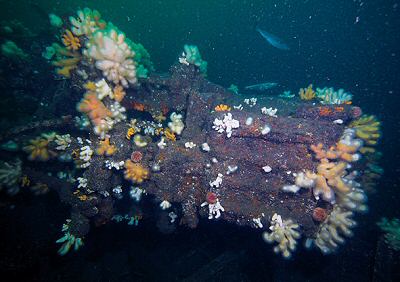
The base of the engine is only a short distance from the mounting-plate still fixed to the keel (12), and in line with the boiler-mounts (2). Features to look out for on the engine mounting-plate are a pair of cut-outs that match up with the crankshaft beneath the engine, to provide room for the downward strokes of the pistons.
The propeller-shaft leads the way aft (13), then the hull soon breaks up, and the propshaft with it.
Wreckage is now mostly to port. Continuing my earlier speculation, this could have been damage from the sinking, or a sign that the stern rolled to port as it broke from the central part of the wreck and collapsed. This theory is supported by the winches (14) that would have served the aft holds having fallen to port, intact on their mounting-plate.
Wreckage is now sparse on the seabed. Perhaps significant sections of hull-plates were salvaged for scrap. Taking a line from the winches, next we come to a curved section of the stern (15), facing completely the wrong way into the wreck.
A small section of keel with the tail-end of the propeller shaft (16) and the stern gland lies in line with the section of propeller-shaft we followed earlier. The remains of the propeller are there, with broken blades still attached.
A little further out and over to port, the last items of wreckage are a section of hull, with the remains of the rudder (17) protruding from underneath.
Visibility is typically quite good, so on a favourable slack it should not be difficult to return to the shotline and ascend, especially as the dive is unlikely to lead to long deco stops. On the other hand, you could be lazy and pop a delayed SMB.
DEATH IN A FORCE 12
RIVER GARRY, steamship. Built 1883, SUNK 1893
TEN YEARS OF SEA LIFE was all the steamship River Garry was to have before a Force 12 hurricane wiped her off the sea and smashed her into Goatness Point near Dunbar and the mouth of the Firth of Forth, writes Kendall McDonald.
Though she called Glasgow her home port soon after her birth in 1883, the 1339-ton iron steamship was built in the yard of Workman Clark in Belfast, to the order of a well-known Glaswegian shipping owner, Henry William Little.
Driven by a single screw from a two-cylinder compound engine of 99hp with a single boiler, the River Garry was 240ft long, a slim ship of 32ft beam that drew 17ft at her deepest. Mr Little was no doubt responsible for the fact that all her machinery was made and fitted by Muir & Houston of Glasgow.
Most of the River Garry’s voyages over the next 10 years were made back and forth from Leith to London, carrying a strange outward-bound mixture of coal and passengers. In command over all those years was Captain John Cavender, also of Glasgow. He seems to have run a happy ship, as most of his 18 crew stuck with him over that time.
The ship behaved well, and her voyages were without any serious incidents until, laden with coal, she left Leith for London on 18 November, 1893.
Then the weather suddenly worsened. The wind came up from the north-north-east and, by the time she neared Dunbar, the River Garry was fighting a losing battle. The wind was a hurricane, the seas enormous, and Captain Cavender must have felt that he was no longer in command.
When they were just a mile north of the town of Dunbar, close to Goatness Point at Torness, the huge wind simply picked up the ship and flung it onto the shore. But it didn’t leave it there. Moments later, the backlash of the waves pulled her into the mountainous seas offshore. The River Garry foundered almost at once.
There were no survivors. Very few of the bodies of Captain Cavender, his 18-man crew and the one passenger aboard were ever found.
TOUR GUIDE
GETTING THERE: Eyemouth is on the A1107, just off the A1. Once in Eyemouth, follow the signs for the harbour. The Harbourside is on the north side.
HOW TO FIND IT: The River Garry sits on a flat seabed with bow to the east. GPS co-ordinates are 55 59.84 N, 002 25.07 W (degrees, minutes and decimals).
TIDES: Slack water is 2 hours 30 minutes after high or low water at Eyemouth
DIVING & AIR : Marine Quest Boat Charter operates North Star and Silver Sky from Eyemouth, 01890 752444. It has an air compressor at the Harbourside.
ACCOMMODATION: Marine Quest is based at the Harbourside, with bunk-room accommodation for up to 15 divers, lounge, TV, free Internet access and a very efficient drying-room for kit.
QUALIFICATIONS: Just beyond PADI Open Water or BSAC Ocean Diver depth.
LAUNCHING: Slips at North Berwick, St Abbs, Eyemouth.
FURTHER INFORMATION: Admiralty Chart 175, Fife Ness to St Abbs Head. Ordnance Survey Map 67, Duns, Dunbar & Eyemouth. Shipwrecks of the Forth, Bob Baird. Berwickshire Dive Tourism Association.
PROS: Shallow enough for a nice long dive, with plenty of time to see it all.
CONS: Just too deep for newly qualified divers to stay within their qualifications.
Thanks to Iain Easingwood and Jim Easingwood.
Appeared in DIVER September 2009
